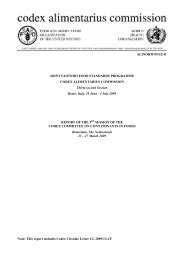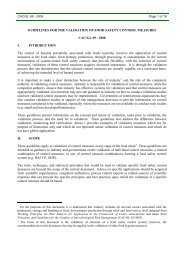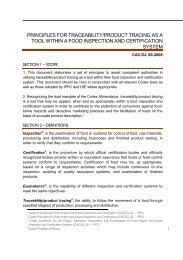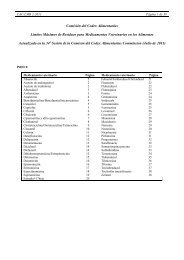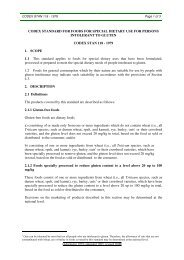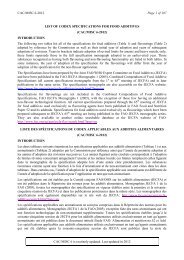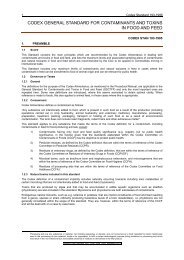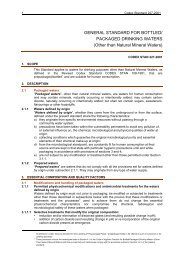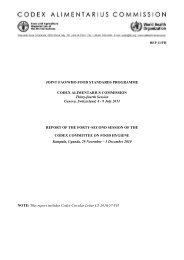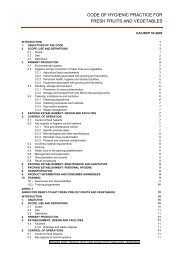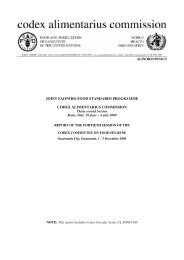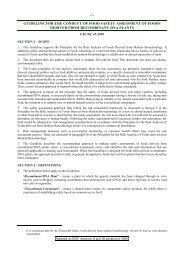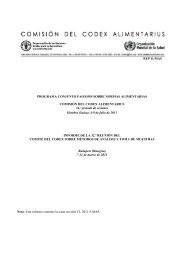General Standard for Food Additives - CODEX Alimentarius
General Standard for Food Additives - CODEX Alimentarius
General Standard for Food Additives - CODEX Alimentarius
You also want an ePaper? Increase the reach of your titles
YUMPU automatically turns print PDFs into web optimized ePapers that Google loves.
<strong>CODEX</strong> STAN 192-1995 Page 20 of 287<br />
01.5.1 Milk powder and cream powder (plain):<br />
19<br />
Milk products obtained by partial removal of water from milk or cream and produced in a powdered <strong>for</strong>m.<br />
Includes casein and caseinates. 20<br />
01.5.2 Milk and cream powder analogues:<br />
Products based on a fat-water emulsion and dried <strong>for</strong> use other than as a beverage whitener (01.3.2).<br />
Examples include imitation dry cream mix and blends of skimmed milk and vegetable fat in powdered <strong>for</strong>m.<br />
01.6 Cheese and analogues:<br />
Cheese and cheese analogues are products that have water and fat included within a coagulated milk-protein<br />
structure. Products such as cheese sauce (12.6.2), cheese-flavoured snacks (15.1), and composite prepared<br />
foods containing cheese as an ingredient (e.g., macaroni and cheese; 16.0) are categorized elsewhere.<br />
01.6.1 Unripened cheese:<br />
21<br />
Unripened cheese, including fresh cheese, is ready <strong>for</strong> consumption soon after manufacture. Examples<br />
include cottage cheese (a soft, unripened, coagulated curd cheese), creamed cottage cheese (cottage cheese<br />
covered with a creaming mixture), 22 cream cheese (rahmfrischkase, an uncured, soft spreadable cheese) 23<br />
mozzarella and scamorza cheeses and paneer (milk protein coagulated by the addition of citric acid from<br />
lemon or lime juice or of lactic acid from whey, that is strained into a solid mass, and is used in vegetarian<br />
versions of, e.g., hamburgers). Includes the whole unripened cheese and unripened cheese rind (<strong>for</strong> those<br />
unripened cheeses with a “skin” such as mozzarella). Most products are plain, however, some, such as<br />
cottage cheese and cream cheese, may be flavoured or contain ingredients such as fruit, vegetables or meat.<br />
Excludes ripened cream cheese, where cream is a qualifier <strong>for</strong> a high fat content.<br />
01.6 2 Ripened cheese:<br />
Ripened cheese is not ready <strong>for</strong> consumption soon after manufacture, but is held under such time and<br />
temperature conditions so as to allow the necessary biochemical and physical changes that characterize the<br />
specific cheese. For mould-ripened cheese, the ripening is accomplished primarily by the development of<br />
21<br />
characteristic mould growth throughout the interior and/or on the surface of the cheese. Ripened cheese<br />
may be soft (e.g., camembert), firm (e.g., edam, gouda), hard (e.g., cheddar), or extra-hard. Includes cheese<br />
in brine, which is a ripened semi-hard to soft cheese, white to yellowish in colour with a compact texture,<br />
and without actual rind that has been preserved in brine until presented to the consumer. 24<br />
01.6.2.1 Ripened cheese, includes rind:<br />
Refers to ripened (including mould-ripened) cheese, including rind, or any part thereof, such as cut,<br />
shredded, grated or sliced cheese. Examples of ripened cheese include: blue cheese, brie, gouda, havarti, hard<br />
grating cheese, and Swiss cheese.<br />
01.6.2.2 Rind of ripened cheese:<br />
Refers to the rind only of the cheese. The rind of the cheese is the exterior portion of the cheese mass that<br />
initially has the same composition as the interior portion of the cheese, but which may dry after brining and<br />
25<br />
ripening.<br />
19 Codex <strong>Standard</strong> <strong>for</strong> Milk Powders and Cream Powder (<strong>CODEX</strong> STAN 207-1999).<br />
20 Codex <strong>Standard</strong> <strong>for</strong> Edible Casein Products (<strong>CODEX</strong> STAN 290-1995).<br />
21 Codex <strong>Standard</strong> <strong>for</strong> Cheese (<strong>CODEX</strong> STAN 283-1978).<br />
22 Codex <strong>Standard</strong> <strong>for</strong> Cottage Cheese (<strong>CODEX</strong> STAN 273-1968).<br />
23 Codex <strong>Standard</strong> <strong>for</strong> Cream Cheese (<strong>CODEX</strong> STAN 275-1973).<br />
24 Codex Group <strong>Standard</strong> <strong>for</strong> Cheeses in Brine (<strong>CODEX</strong> STAN 208-1999).<br />
25 The rind is different from the coating of a cheese. The coating is either: (1) a film of synthetic or natural material,<br />
which helps to regulate the humidity during ripening and protects the cheese against microorganisms; or (2) a layer,<br />
primarily of wax, paraffin or plastic, which normally is impermeable to moisture, that protects the cheese after ripening<br />
against microorganisms and against physical damage during retail handling and that in some cases, contributes to the<br />
specific appearance of the cheese (e.g., coloured surface).



